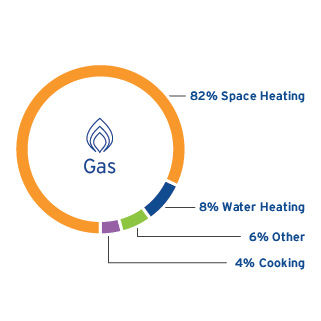Schools
Nationwide, schools spend more than $8 billion per year on energy, which is more than the annual cost of books and supplies. To help lower the cost of education, DTE Energy offers many ways learning facilities can reduce energy expenses. So do your homework! Because the more you know, the more you can save.
Schools — Typical Energy Usage


Source: U.S. Energy Information Administration
Energy Tips for Schools
Appliances
Drinking Fountains
Water fountains generally don’t need to provide ice-cold water 24 hours a day unless it’s required for health reasons. In most cases, you can turn off the cooling systems in drinking fountains during off hours.
Vending Machines
Refrigerated vending machines typically operate 24 hours a day, using 2,500 to 4,400 kWh per year. These units also give off significant heat, adding to building cooling loads. Timers or occupancy sensors can yield significant savings because they allow the machines to turn on only when a customer is present or when the compressor must run to maintain the product at the desired temperature.
When it’s time to replace or add vending machines in your facilities, use ENERGY STAR®–certified models. Each one can save you more than $150 annually on utility bills.
Cooking
Commercial Steam Cookers
ENERGY STAR®-certified commercial steam cookers save 4,930 kWh (electric models) or 33 MBtu (gas models) annually. This equates to an annual savings of nearly $510 on utility bills.
Hot Food Holding Cabinets
Hot food holding cabinets that are ENERGY STAR®-certified are 70 percent more energy efficient than standard models. On average, ENERGY STAR®-certified models can save $300 per year on electricity or more than $2,800 over the lifetime of the product when compared to a standard model. Good practices can save $650 annually by turning off an uninsulated holding cabinet when the kitchen is closed (8 hours).
Reduce Vent Hood Use
Vent hoods are among the most energy-intensive equipment on college campuses and should be kept off unless they’re needed.
HVAC
Align Systems With Occupancy Schedule
Facility engineers should coordinate HVAC schedules in the building automation system (BAS) with expected occupancy to optimize energy usage. Buildings that are not used at night, on weekends or for long periods of time (such as during semester breaks) should have their temperature settings adjusted. For facilities with regular occupancy schedules without a BAS, programmable thermostats make temperature setbacks a reliable option.
Reduce Ventilation During Low Occupancy
For spaces that have large swings in occupancy (such as auditoriums, gyms, classrooms and cafeterias), energy can be saved by decreasing the amount of ventilation supplied by the HVAC system during low-occupancy hours. A demand-controlled ventilation system senses the level of carbon dioxide in the return air stream, uses it as an indicator of occupancy, and decreases supply air when carbon dioxide levels are low.
Maintain A/C Economizers
Many air-conditioning systems (other than those in hot and humid climates) use a dampered vent called an economizer to reduce the need for mechanically cooled air by drawing cool outside air into the building. If the economizer isn’t regularly checked, the linkage on the damper can seize up or break. An economizer that’s stuck in the fully open position can add as much as 50 percent to a building’s annual energy bill by allowing hot air in during the air-conditioning season and cold air in during the heating season.
Maintain Rooftop A/C Units to Maximize Efficiency
On a quarterly basis (or after filters are changed), make sure the panels to your packaged rooftop air-conditioning unit are fully attached, with all screws in place and all gaskets intact so no air leaks out of the cabinet. Over the course of a year, leaking chilled air can cost $100 per rooftop unit in wasted energy.
Adjust Chillers to Load Needs
Operators often run too many chillers for a given load. Every chiller has a range of loading conditions in which it operates most efficiently. Turn chillers off to keep the remaining units operating in their most efficient zones — typically above the 30 to 50 percent load mark.
Steam
Follow a Steam Trap Inspection and Maintenance Plan
Steam traps remove water from the steam distribution system once it has cooled and condensed in radiators or other heat exchangers. Mechanical steam traps can become stuck open, which wastes heat. A single failed trap can waste more than $50 per month, and universities can have thousands of steam traps on a campus.
Lighting
Use Daylight Sensors
Where possible, take advantage of natural daylight. Dimming ballasts and sensors can reduce the amount of electric light used when daylight is present. Solar light tubes can also be a cost-effective retrofit.
Use Occupancy Sensors
Occupancy sensors can turn off lights when spaces and rooms are not in use. Additionally, energy conservation-themed posters and stickers placed around campus can be effective reminders to turn off lights, especially when designed as part of a larger energy-awareness campaign.
Parking Lot LED Lighting
Parking lots are often over lit — an average of 1 foot-candle of light or less is usually sufficient. Fluorescent lamps, CFLs, LEDs and induction lamps have become viable sources for outdoor lighting, providing good color quality and better control options than traditional parking lot lighting sources.
Use Exterior LED Lighting
Using LEDs to light stadiums and sports arenas can yield large energy savings — roughly 75 percent over Metal Haline (MH) lamps. Thanks to a longer bulb life, LEDs also reduce maintenance costs and lower lumen depreciation rates. Facility operators will also appreciate the bulb’s instant-on and instant-restrike capabilities.
Currently, LED fixtures can cost up to four times as much as MH fixtures, but the dramatic energy and maintenance savings can make them an economical measure with potential payback periods as short as two to three years.
Energy Efficiency
Implement Energy-Efficiency Measures
By implementing cost-effective energy-efficiency measures, many colleges and universities have the potential to cut their energy bills by 30 percent or more.
Sources: energystar.gov and Business Energy Advisor.
